Best Reef-Safe Sunscreen Spray
Sun Bum Mineral SPF 30 Sunscreen Spray
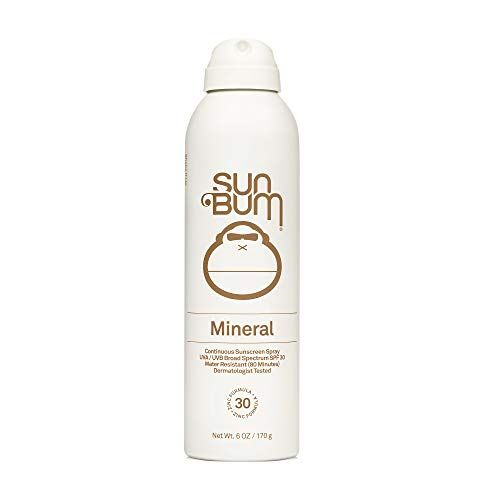
Best Reef-Safe Sunscreen Spray
Sun Bum Mineral SPF 30 Sunscreen Spray
Now 13% Off
ConsLeaves a white residue
This brilliant solve for gloopy, thick mineral sunscreen comes out of the can in a whipped cream consistency, which makes it easier to rub in and feel lighter on the skin. It still leaves a slight white cast at first, but is useful to see if you’ve missed a spot before it disappears.
Testing Notes: We love the ease of application of this sunscreen. It sprays out in a fine mist, which allows you to get those hard-to-reach areas like your back. It has thin consistency, but since it’s mineral, it doesn’t exactly blend into your skin. Expect to see a white-ish tint after using, which indicates you’re protected from the sun. It also makes it easy to know when you need to reapply. We would only recommend this reef-safe sunscreen for those with fair to light complexions, unless you don’t mind looking like Casper the Friendly Ghost at the beach.
Read more: Best Natural Sunscreens for Men
SPF30Size6 ouncesWater resistanceUp to 80 minutes
Best Fragrance-Free Reef-Safe Sunscreen
Coola Organic Mineral Sunscreen SPF 50

Best Fragrance-Free Reef-Safe Sunscreen
Coola Organic Mineral Sunscreen SPF 50
ConsSlightly greasy texture
This fragrance-free zinc sunscreen lotion is top rated by the EWG because of the 70% organic formula and high quality plant-derived ingredients. Since there’s no added fragrance, it’s gentle enough to use on sensitive or irritation-prone skin.
Testing Notes: We found that it takes some vigorous rubbing to get this sunscreen completely blended into the skin, but your patience will be rewarded. We can really feel a difference when it comes to the ingredients in this sunscreen versus others. Antioxidant-rich nutrients like red raspberry seed oil, meadowfoam seed oil, and prickly pear extract provide a moisturizer-like texture that actually makes us want to reapply. If a day in the sun leaves your skin feeling extra dry, you might enjoy this nourishing reef-safe sunscreen.
SPF50Size5 ozWater resistance80 minutes
Best Mineral Reef-Safe Sunscreen
REN Clean Screen Mattifying Face Sunscreen SPF 30
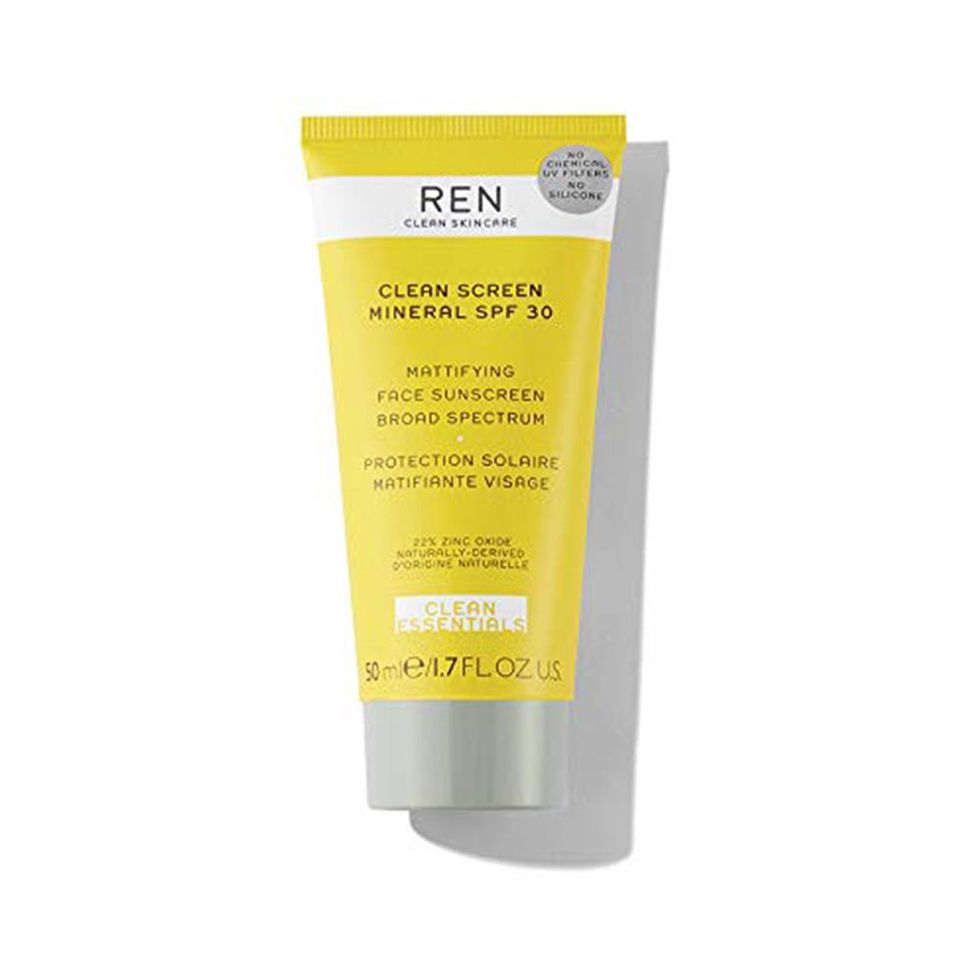
Best Mineral Reef-Safe Sunscreen
REN Clean Screen Mattifying Face Sunscreen SPF 30
Wearing mineral sunscreen on your body is one thing, but how it feels on your face is another. This clean-ingredient formula contains zinc to help protect your face from UV rays but is non-greasy and contains rice starch to help soak up excess oil.
Testing Notes: Hate the feeling of greasy sunscreen? Us too. We love this sunscreen because it dries matte and doesn’t contain dimethicone like other sunscreens, which gives some sunscreens that slippy quality. We found that warming the product up in your hands before applying it on your face helps it ‘melt’ into the skin. If you don’t warm it up, it might be difficult to blend and leave behind a white cast.
Read more: Best Mineral Sunscreen for Men
SPF30Size1.7 ouncesWater resistanceNone
Advertisement – Continue Reading Below
Most Innovative Sunscreen
Bare Republic Mineral Gel Sunscreen SPF 30 Sunblock Body Lotion

Most Innovative Sunscreen
Bare Republic Mineral Gel Sunscreen SPF 30 Sunblock Body Lotion
ConsSmell can be unpleasant to some
This innovative clear gel completely does away with the white, chalky look of some other mineral sunscreens, but still has non-nano zinc oxide particles to give broad spectrum protection. It’s also chock-full of botanical oils to help moisturize skin as well as protect it.
Testing Notes: We love this reef-safe sunscreen for dry skin, thanks to the hydrating plant-based ingredients including aloe, shea butter, and sunflower seed oil. The gel-lotion texture is super lightweight and allows it to sink into the skin faster without having to rub your face off like you’re scratching a lottery ticket. If you have oily skin, this sunscreen might be too rich for your skin type, but for dry skin, it’s incredible to help prevent your skin from flaking after a fun day in the sun.
SPF30Size4 ouncesWater resistanceUp to 40 minutes
Best Mineral-Safe Zinc Sunscreen
Thinksport Sunscreen SPF 50+

Best Mineral-Safe Zinc Sunscreen
Thinksport Sunscreen SPF 50+
ConsCan be hard to rub in
Almost as close to pure zinc as you can get (while still sinking into skin quickly and without a greasy film), this mineral-based sunscreen is approved by the EWG and Whole Foods. It’s best suited when you’re being especially active, because of the 80-water resistant factor which applies to sweat, too.
Testing Notes: We love using this sunscreen before any outdoor activity because it’s sweat and water-resistant. Plus, it doesn’t feel heavy on our skin, like it’s sitting on the surface. The best way to apply it is in thin layers. If you squeeze out a giant glob of it, you might find it difficult to rub in. Applying it in thin layers ensures you are protected while also preventing the dreaded white cast that can happen with most reef-safe sunscreens.
Read more: Best Zinc-Oxide Sunscreens for Men
SPF50Size6 ouncesWater resistanceUp to 80 minutes
Best Matte Reef-Safe Sunscreen
Neutrogena Sheer Zinc Oxide Dry-Touch Sunscreen Lotion SPF 30

Best Matte Reef-Safe Sunscreen
Neutrogena Sheer Zinc Oxide Dry-Touch Sunscreen Lotion SPF 30
Now 21% Off
ConsCan leave a white cast
“Neutrogena makes a lot of good zinc sunscreens and has good science behind it,” says Dr. Bhanusali. We’re partial to this zinc formula which goes on smooth and dries to a powdery finish that doesn’t leave you with a grey film or sticky feeling (there is also a version specifically for your face).
Testing Notes: We’re huge fans of the texture of this reef-safe sunscreen. It’s not sticky or overly creamy and dries down to a sheer matte finish that won’t lave your face looking shiny or greasy. The non-greasy formula is easy to spread on its own, but it blends even better if you apply it on top of your daily moisturizer. Within a few minutes, it’ll feel weightless on your skin.
SPF50Size3 ounces eachWater resistanceUp to 80 minutes
Advertisement – Continue Reading Below
Most Comfortable Reef-Safe Sunscreen
Supergoop! PLAY 100% Mineral Lotion SPF 50 Sunscreen
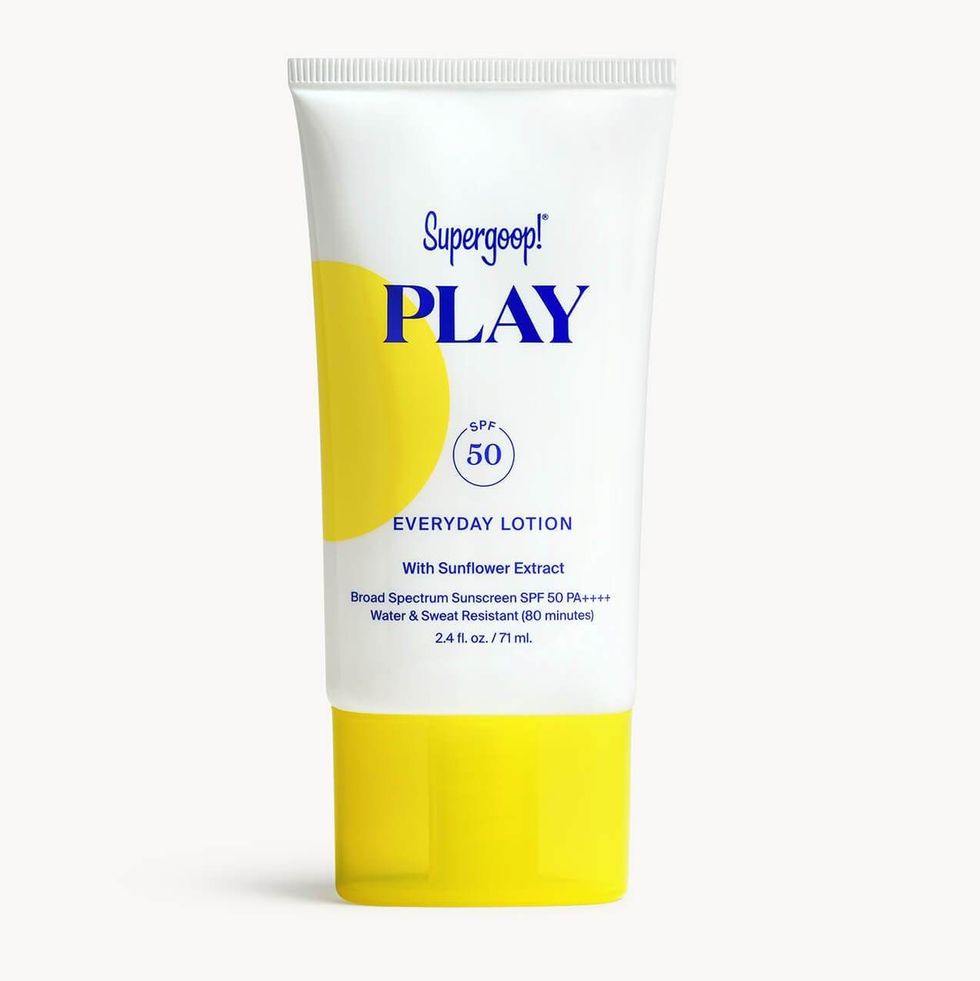
Most Comfortable Reef-Safe Sunscreen
Supergoop! PLAY 100% Mineral Lotion SPF 50 Sunscreen
ConsExpensive
There are no chemical sunscreens in this formula, only a powerful combination of zinc oxide and titanium dioxide. It’s lightweight enough for your face, but protective enough to use on your body, too. It sinks in quickly without feeling heavy on your skin.
Testing Notes: We found that the texture of this sunscreen is really elegant compared to other mineral sunscreens, which can be quite thick. Despite its thin consistency, it doesn’t lack in terms of coverage. A little goes a long way, but it’s also easy to layer and reapply. We recommend putting some in your hand, rubbing them together and patting it on your skin before rubbing it in completely. This application method gives you complete coverage without having to work too hard to blend.
SPF50Size1 to 18 ouncesWater resistanceUp to 80 minutes
Best Reef-Safe Sunscreen for Travel
Babo Botanicals Clear Zinc Sport Sunscreen Stick SPF 30

Best Reef-Safe Sunscreen for Travel
Babo Botanicals Clear Zinc Sport Sunscreen Stick SPF 30
Now 15% Off
ConsLeaves a white residue
This EWG-approved, non-nano mineral sunscreen formula also comes in a lotion, but we especially like the stick because it makes sunscreen easy to apply on areas most prone to sunburn like ears, noses, and even lips. Plus, it makes reapplying every two hours less of chore.
Testing Notes: A stick isn’t our preferred method of applying sunscreen. If you plan to be out in the sun for multiple hours, we definitely recommend using a liquid reef-safe sunscreen as your primary sun protection strategy. This sunscreen stick is great to keep handy if you’re going on a bike ride or a long run and don’t want to carry an entire tube of sunscreen when it comes time to reapply. Since it is a solid, we found that this sunscreen can be tricky to rub in, which causes it to leave a heavy white cast. To make it blend easier, we recommend rubbing the stick on the palm of your hands to warm up the formula a bit before rubbing it on your face.
SPF30Size.6 ouncesWater resistanceUp to 80 minutes
Best Organic Reef-Safe Sunscreen
Badger Active Broad Spectrum Sunscreen Cream SPF 30
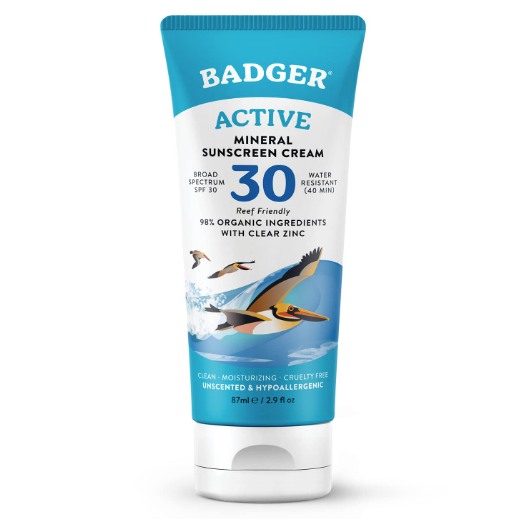
Best Organic Reef-Safe Sunscreen
Badger Active Broad Spectrum Sunscreen Cream SPF 30
Now 24% Off
ConsCan leave a shiny finish
With only five ingredients in this Protect Land + Sea certified formula, Badger sunscreen is as natural is you can find, but doesn’t sacrifice any sun protection. There’s a high concentration of zinc to protect from UV rays, but somehow still applies smoothly and doesn’t leave your limbs sticky.
Testing Notes: We love how simple this formula is, which gives us the confidence to reapply without worrying that it might irritate our skin. The addition of sunflower oil, beeswax, and vitamin E helps this sunscreen spread easily and absorb into the skin, but it also gives your skin a slightly shiny finish. Be warned that it can rub off on clothing or gear, so we recommend that you clean your hands before touching anything.
SPF30Size2.9 ouncesWater resistanceUp to 40 minutes
Advertisement – Continue Reading Below
Best Moisturizing Reef-Safe Sunscreen
Australian Gold Botanical Sunscreen SPF 50

Best Moisturizing Reef-Safe Sunscreen
Australian Gold Botanical Sunscreen SPF 50
ConsCan be too light for melanin-rich skin
As mineral sunscreens climb higher in SPF, some can start feeling heavier and stickier with greater sun protection. That’s not the case with this formula. It contains ingredients like squalane and red algae to help moisturize and protect skin, while also allowing it to spread easily and quickly.
Testing Notes: We love that this sunscreen doesn’t smell like your typical sunscreen. It has a natural citrus scent that isn’t too strong. Unlike other sunscreens, it dries down to an almost powdery finish. We wouldn’t recommend this sunscreen for dry skin, but if you have oily skin, you’ll love how this sunscreen instantly mattifies your complexion.
SPF50Size5 ouncesWater resistanceUp to 80 minutes
Best Luxury Reef-Safe Sunscreen
Drunk Elephant Umbra™ Sheer Physical Daily Defense Broad Spectrum Sunscreen SPF 30
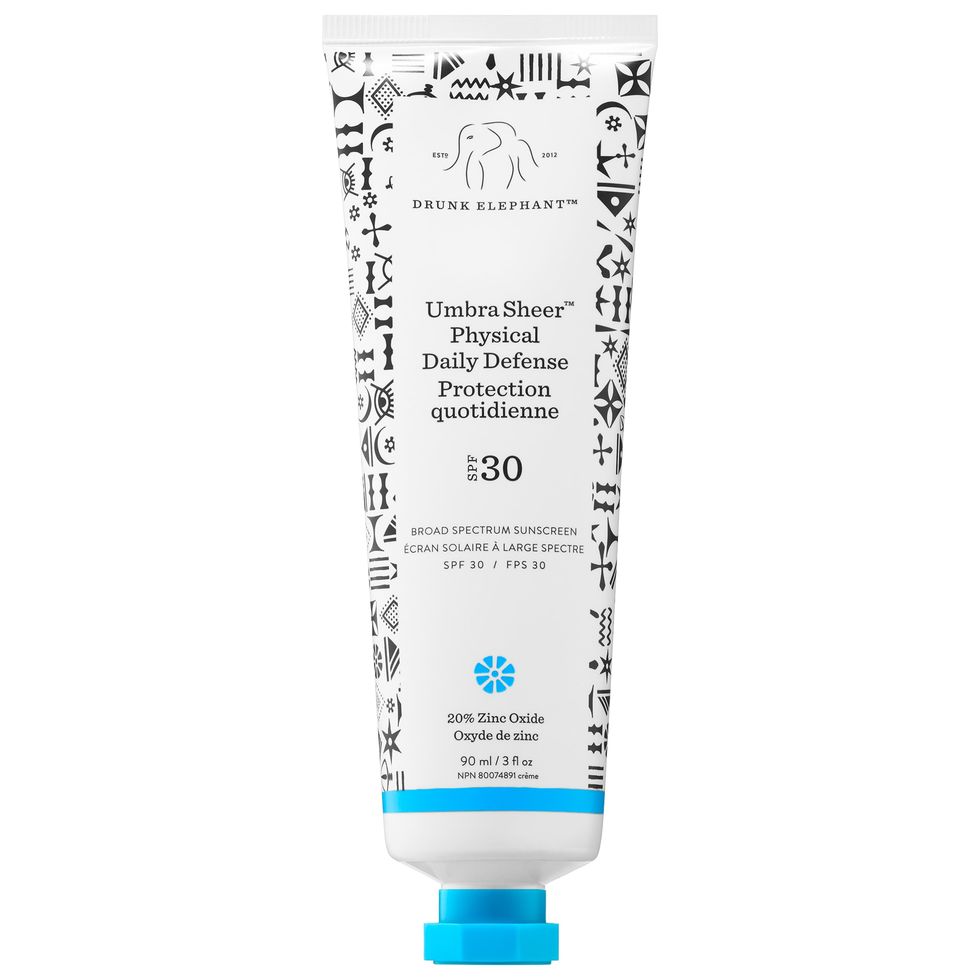
Best Luxury Reef-Safe Sunscreen
Drunk Elephant Umbra™ Sheer Physical Daily Defense Broad Spectrum Sunscreen SPF 30
ConsDoesn’t last as long as other brands
On the luxe end of the spectrum, this Drunk Elephant mineral sunscreen costs a bit more than others, but is ideally suited for everyday wear on your face. It contains zinc to help protect your mug from UVA and UVB rays, as well as ingredients like soothing aloe and jojoba oil to keep it moisturized.
Testing Notes: If you’re worried about your reef-safe sunscreen leaving a white cast, we encourage you to give this one a shot. It comes out white from the tube but after rubbing it in for a minute or two, it’s almost completely sheer. The only negative is that you do have to reapply it, especially if you plan on being in the water, as it’s not water resistant. We love this one for daily sun protection, however, it’s not our top choice for bringing to the beach.
SPF 30Size3 ouncesWater resistanceNo
Best Hypoallergenic Reef-Safe Sunscreen
Coppertone Pure & Simple SPF 50 Sunscreen Lotion

Best Hypoallergenic Reef-Safe Sunscreen
Coppertone Pure & Simple SPF 50 Sunscreen Lotion
Now 13% Off
ConsLeaves a heavy white cast
This EWG-approved formula from Coppertone is made of zinc oxide and natural botanicals, like tea leaf and sea kelp extracts. It’s also hypoallergenic and suitable for even the most sensitive skin.
Testing Notes: We love that this sunscreen is made with 100% naturally sourced zinc oxide, which is gentle on the skin, but we found that it never truly absorbs; it just sits on the surface of your skin. That being said, we found that it stays on your skin even after an hour of being in the water, which is quite impressive. As an SPF 50, it works to give your skin the best level of protection, but it does come at the cost of a heavy white cast. If you have a medium or deeper skin tone, you might want to skip this one.
SPF50Size6 ouncesWater resistanceUp to 80 minutes
Advertisement – Continue Reading Below
How Exactly Can Sunscreen Harm the Environment?

Ultimately it comes down to what kind of sunscreen it is. “The issue is more with chemical sunscreens because those are the ones that have been shown to accumulate [in the water],” says cosmetic chemist Ron Robinson, whereas mineral-based sunscreens like zinc oxide and titanium dioxide don’t, at least not in the same way. “[Chemicals] get absorbed by some of the marine life and cause damage and even death. Minerals sink to the bottom.” According to Downs, coral bleaching is the most visible effect of damage but it goes way beyond that. These chemicals can affect all aspects of an ocean ecosystem—from fertility issues in sea urchins and fish to killing off seaweed and other marine plant life. “Sunscreens are incredible herbicides, worse than commercial herbicides,” says Downs.
What’s the Difference Between Chemical and Mineral Sunscreens?

“In the simplest terms, mineral [also called physical] sunscreens deflect UV rays and chemical sunscreens actually absorb them and use heat to break them apart,” says dermatologist Dhaval Bhanusali, MD. Physical sunscreens also tend to be natural, like zinc oxide or titanium dioxide, whereas chemical sunscreens are synthetic. The easiest way to think about it is to picture the old-school lifeguards or surfers with pure white zinc on their noses. These physical blockers actually sit on top of skin, which is why dermatologists like Dr. Bhanusali actually prefer them. “They do a better job of protecting us, but the biggest issue is that people don’t always like them because they leave a barrier,” he says. That’s why chemical sunscreens were developed—they sink into skin easier and don’t usually leave a white, chalky cast. These days, however, formulations of mineral sunscreens are getting better and grind the minerals down to a microscopic size called nanoparticles to ensure they disappear on skin quicker and more easily without leaving a film or chalky look.
But nanoparticles aren’t perfect, even those of natural substances like zinc or titanium dioxide. “They tend to accumulate god knows where,” says Dr. Bhanusali. As manufacturers began to micronize particles smaller and smaller, “they went too far,” says Robinson. “There are potentially harmful effects as they seep into the skin,” which can be bad news for humans as well as marine life. “Nanoparticles still pose an increased toxicological risk because, just like in humans, they can be absorbed into the blood stream [of marine life],” says Downs. The impact is still being studied and may not be as extreme in some cases as chemical sunscreens, but is still something scientists like Downs are concerned about. “It’s the dose that makes the poison, so if you had 6,000 people go into [the same water] with nanosized zinc oxide, yes, I think there would be an impact,” he says.
What Makes a Sunscreen Reef Safe?

Keep in mind that “reef safe” is not a standardized term – it’s something come up by marketers. “Calling something reef safe implies you’ve actually tested that product on reef organisms and most companies don’t do that toxicity testing,” says Downs. When you see the words reef safe on a bottle, it usually just means it’s free from oxybenzone and octinoxate, which is a start but not the be-all-end-all. To be as safe as possible, the sunscreen should contain only non-nano mineral sunscreens.
“For a reef-safe option, men can opt for mineral sunscreens containing zinc oxide or titanium dioxide as active ingredients,” says Beverly Hills-based integrative aesthetics doctor Dr. Rahi Sarbaziha. “These sunscreens work by creating a protective layer that shields the skin from UVA/UVB rays.”
There are some independent agencies who have set up their own certification and testing processes to help identify sunscreens that don’t contain harmful ingredients. Protect Land & Sea, which Downs oversees, tests sunscreens for 11 potentially harmful chemicals as well as a slew of other things like parabens and other preservatives. The Environmental Working Group also has rigorous standards in what they consider safe to use. Look for their logos on packages to help easily identify products that they deem safe.
Advertisement – Continue Reading Below
Can Using a Reef-Safe Sunscreen Really Make a Difference?

Cynics among us may wonder if saving marine life could be as simple as switching their sunscreen. There are multiple factors to consider, according to Dr. Bhanusali, like climate change and pollution, which also contribute to the deterioration of coral reefs and nothing is black and white. “The only thing that’s non-negotiable,” he says, “is that you have to wear something because extended UV damage over time can lead to skin cancers.” And if you’re still unconvinced, consider this: physical sunscreens can actually protect you better from the sun’s rays. Mineral ingredients like zinc oxide and titanium dioxide are broad spectrum protectors, which means they protect from UVA and UVB rays (not all chemical sunscreens protect you from both). So switching to a reef safe sunscreen could do your body good as well as the ocean.
Basically, says Robinson, you have to make the decision for yourself. “If you’re going swimming in the ocean, I would choose a product that is reef safe,” he says. “If you’re going to the beach and laying out, it doesn’t matter as much.” But consider that, as Downs says, “the poison is in the dose.” The harmful chemicals in sunscreens compound over time, so even one person making the switch could make a difference.
How to Choose A Reef Safe Sunscreen

One of the biggest reasons people stay away from mineral sunscreens is how they look (chalky) and feel (filmy) on their skin. That may have been true for the old-school zinc, but now formulas are smoother and easier to rub in, though may still take some getting used to. “Buy a few different sunscreens and try them all to figure out which one your skin likes best because all skin is different,” says Bhanusali. “People may have reactions to certain ingredients, so you have to play around with it.” Always choose a sunscreen that is at least broad spectrum SPF 30, as advised by the American Academy of Dermatology, and look for versions that are water resistant. Be wary of any product that doesn’t list an SPF rating, since those are substantiated and regulated by the FDA, even if some of the ingredients are not. And if you can’t find a mineral sunscreen you like, but still want to be reef safe, consider UPF clothing which still protects your skin from UV rays.
Meet the Experts

Advertisement – Continue Reading Below
How We Selected

For the past two years, we consulted with Men’s Health’s Grooming editors and writers on the top reef-safe sunscreens for men. Experts including our Grooming Editor Garrett Munce have tried over 100 reef-safe sunscreens and evaluated them for their protection, texture, and finish, and if their ingredients lined up with the Protect Land & Sea’s requirements for a reef-safe sunscreen. We also considered top-reviewed sunscreens that had at least 100 five-star customer ratings on e-commerce websites that we trust.
Cristina Montemayor
Cristina Montemayor is a freelance writer and journalist living in Austin, Texas, covering beauty, grooming, style, and culture. Her work has appeared in Very Good Light, BRIDES, Elite Daily, among others.
Garrett Munce writes about men’s style and grooming. He’s written for Esquire, New York Magazine, Spotlyte, and Very Good Light and held staff positions at GQ and W. Follow his skincare obsession on Instagram at @garrettmunce.
Deputy Editor, Commerce
As Men’s Health’s Deputy Editor, Commerce, Christian Gollayan oversees all shopping content on menshealth.com. He relocated back to New York by way of Portland, where he was the Associate Managing Editor at TheManual.com. Christian’s work has also been featured in InStyle, Food & Wine, the New York Post, and Tatler Asia.
>>> Read full article>>>
Copyright for syndicated content belongs to the linked Source : Men’s Health – https://www.menshealth.com/grooming/g32581649/best-reef-safe-sunscreen/































